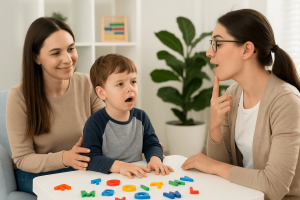Role of Neuroplasticity in Early Childhood Language Development
Last Updated: December 17, 2024
Have you ever wondered how young kids learn to talk and understand words so quickly? It’s not just about teaching them; it’s also because their brains are growing and changing. This amazing skill comes mainly from something called neuroplasticity. Neuroplasticity in childhood language development is about the brain’s ability to change when kids have new experiences. This is very important when they are learning to talk.
Neuroplasticity helps young brains get really good at picking up language skills. When kids listen to people talking, get read to, or sing along in songs and stories, it helps their brain make and strengthen connections.
Understanding Neuroplasticity
What is Neuroplasticity?
Neuroplasticity might sound like a tough word, but it really just means how flexible our brains are. It’s the brain’s ability to change and grow throughout our lives because of our experiences, behaviors, or even injuries. When we learn something new, such as during the crucial phase of neuroplasticity in childhood language development, our brain doesn’t just store information—it actually changes its shape! Connections between neurons, which are like tiny brain cells, get stronger or weaker depending on what we do and learn. This flexibility is especially significant in young children, as it underpins their rapid acquisition and development of language skills.”
This ability to change is why we can learn new things like playing an instrument or get better after a brain injury. Each time you learn a new skill or remember something important, your brain adjusts a little.
How Neuroplasticity Helps Kids Learn to Talk
In young kids, neuroplasticity in childhood language development makes the brain super flexible, allowing it to build new connections quickly. Every new word they learn, every sentence they understand, and every direction they follow helps build and strengthen their brain pathways. This period is crucial for developing language skills, which help them communicate more effectively, enhance cognitive abilities, and boost self-esteem.
The Impact of Neuroplasticity on Language Learning in Kids
How Brain Development Boosts Language Skills
The place where a child grows up plays a huge role in how well they learn to talk. Everything from the everyday talks at home to fun learning at preschool helps build their language skills. It’s like each word they hear is adding a little bit to their brain, helping them understand and use language better.
The environment where a child grows up plays a crucial role in how they learn to communicate, thanks to neuroplasticity in childhood language development. From daily conversations at home to interactive learning at preschool, every word they hear contributes to their growing brain, enhancing their ability to understand and use language. As children frequently hear new words, their brain leverages neuroplasticity to form new connections. The more they use and hear these words, the stronger these connections become. This enhancement in brain connections not only expands their vocabulary but also improves their grasp of grammar, pronunciation, and complex concepts.
Overview of Neuroplasticity’s Impact on Language Development
| Age Group | Key Benefits of Neuroplasticity | Examples of Neuroplasticity in Action | Suggested Activities |
|---|---|---|---|
| Infants (0-1 year) | – Rapid vocabulary acquisition – Early phonetic learning | – Responding to parental voices – Recognizing and mimicking simple sounds | – Singing lullabies – Simple games like peek-a-boo – Talking directly to the infant |
| Toddlers (1-3 years) | – Sentence formation – Understanding complex instructions | – Learning new words daily – Starting to follow two-step instructions | – Reading storybooks aloud – Engaging in two-way conversations – Singing children’s songs |
| Preschool (3-5 years) | – Grammar mastery – Enhanced storytelling skills | – Using full sentences – Creating their own stories during play | – Interactive read-aloud sessions – Role-playing games – Simple word games |
| Early School Age (5-8 years) | – Advanced language use – Improved writing skills | – Writing simple stories – Using language to solve problems in school | – Writing exercises like keeping a journal – More complex language games – Group discussions |
Real Examples of How Neuroplasticity Helps Kids Learn to Talk
Let’s look at a couple of stories to see how amazing neuroplasticity is in helping kids learn languages:
- Sophia’s Story: Sophia was raised in a home where both English and Spanish were spoken. At first, she mixed up the languages when she talked. But as her brain developed, she started to use the right language with the right person, showing she could handle both languages well.
- Liam’s Progress: Liam went to a preschool where they loved to tell stories and sing. At first, he didn’t talk much and knew only a few words. But thanks to songs that were easy to remember and repeat, he soon started to talk more and use more words, showing how great a good language environment is for brain development and learning languages.
Practical Applications of Neuroplasticity in Language Learning
Techniques to Stimulate Neuroplasticity in Young Children
Harnessing the power of neuroplasticity in childhood language development can significantly enhance language growth in young children. Here are some effective activities and exercises designed to stimulate brain adaptation and facilitate this development:
- Interactive Read-Alouds: Reading stories to children is more than just a bedtime routine; it’s a powerful tool for enhancing language development. As you read, pause to ask questions about the story, encourage predictions of what might happen next, and discuss the characters’ feelings and actions. This interactive approach engages multiple areas of the brain, fostering connections essential for language comprehension and cognitive development.
- Music and Movement: Songs, rhymes, and dance are not only fun but also incredibly beneficial for young learners. Music stimulates areas of the brain associated with language comprehension and production. Encouraging children to sing along and move to the rhythm helps develop auditory discrimination skills and motor coordination, crucial for speech.
- Labeling and Describing Games: Turn everyday activities into language lessons by asking children to label objects around them and describe their attributes or actions. For example, during a walk in the park, you might say, “I see a tree. What do you see?” or “Tell me about your toy car. What color is it?” These simple prompts encourage verbal expression and vocabulary building.
- Storytelling and Role Play: Children love stories and pretending. Create opportunities for them to tell their own stories or act out scenarios. This not only boosts their narrative skills but also enhances creativity and problem-solving abilities, which are linked to better linguistic skills.
Incorporating Neuroplasticity in Everyday Learning
Creating an environment that promotes neuroplastic development involves everyday interactions and structured activities that are key to neuroplasticity in childhood language development. Here are some tips for parents and educators to foster such an environment:
- Rich Language Environment: Surround children with a rich language environment where words and conversations are part of the daily routine. The more language they hear, the more opportunities their brains have to develop those crucial neural pathways, harnessing neuroplasticity for language development.
- Consistency and Routine: Regular routines help reinforce learning. Consistent activities like reading at bedtime or singing a particular song each morning help reinforce language structures in fun and memorable ways, supporting the neuroplastic growth crucial for language acquisition.
- Encouragement and Feedback: Positive reinforcement can motivate children to use their language skills more frequently. Celebrate their efforts to communicate, correct gently, and provide alternatives to help them learn the appropriate usage and pronunciation, thus enhancing their neuroplastic development.
- Exposure to Diversity: Expose children to different languages and dialects if possible. This exposure can enhance auditory discrimination and increase cognitive flexibility, making it easier for them to learn and adapt to new linguistic environments, leveraging neuroplasticity to facilitate language learning.
Challenges and Considerations
Potential Challenges in Leveraging Neuroplasticity
While neuroplasticity in childhood language development offers immense potential for enhancing language skills, leveraging it effectively can present certain challenges. Understanding these obstacles is crucial for developing strategies that truly benefit young learners.
- Critical Periods: Neuroplasticity is most effective during certain “critical periods” of development when the brain is extraordinarily receptive to learning new skills such as language. Missing these windows can make language acquisition more challenging, though not impossible, later on.
- Variability in Development: Each child is unique, and so is their pace of neurological development. Some children may naturally pick up language skills quickly, while others may need more time and targeted interventions to make the same gains, which can be a source of frustration for parents and educators alike.
- Environmental Factors: A stimulating environment is key to leveraging neuroplasticity, but not all children have equal access to rich linguistic and sensory experiences. Socioeconomic factors, for instance, can limit exposure to diverse vocabulary, books, and educational opportunities, affecting language development.
- Overstimulation: In our zeal to stimulate neuroplasticity, there’s also a risk of overstimulation. Bombarding children with too much information can lead to confusion and fatigue, making it harder for them to absorb and retain new skills.
Addressing Special Needs Using Neuroplasticity Principles
Neuroplasticity holds significant promise for supporting children with speech or language delays. Tailoring interventions to harness neuroplasticity can help mitigate these delays effectively.
- Individualized Learning Plans: Children with speech or language challenges benefit greatly from personalized learning plans that are tailored to their specific needs. These plans can focus on gradually building language skills through repetitive and incremental challenges that encourage brain adaptation without causing frustration.
- Technology-Enhanced Learning: Digital tools and applications designed for language learning can provide interactive experiences that adapt to a child’s learning pace and style. Wellness Hub offers resources that are not only engaging but also customizable to fit the needs of children with varying abilities, making learning accessible to all.
- Multisensory Approaches: Integrating visual, auditory, and tactile elements into language learning can stimulate multiple pathways in the brain, enhancing the neuroplastic response. For children with language delays, multisensory techniques can facilitate better retention and understanding of language concepts.
- Family Involvement: Family members play a crucial role in reinforcing language skills. Encouraging parents to engage in language-rich activities at home, such as reading together, singing, and conversational games, can significantly boost the effectiveness of formal therapies.
The Future of Neuroplasticity and Language Development
Emerging Research and Trends
As we look to the future, exciting developments in neuroplasticity are promising to transform how we support language learning. Here’s a glance at what’s coming:
- Tailored Learning Programs: Scientists are working on ways to understand each child’s brain better. This could lead to customized language programs that perfectly match how each child learns best, making language learning more effective.
- Virtual Experiences: Technologies like augmented reality (AR) and virtual reality (VR) are starting to be used to teach languages. They can create fun, interactive environments that feel like real-life places where children can practice new languages as if they were actually there.
- Brain Boosting Techniques: Researchers are exploring ways like brain stimulation to directly enhance how the brain learns. This could one day help make learning a new language easier by boosting the parts of the brain involved in language.
- Learning Multiple Languages: Being bilingual or even multilingual has great benefits for the brain. It makes the brain more flexible and good at learning new things. Schools and programs might start teaching kids multiple languages early on to take advantage of these benefits.
Conclusion
Neuroplasticity plays a crucial role in how children learn language during their early years. This ability of the brain to adapt helps shape their language and thinking skills. At Wellness Hub, we utilize neuroplasticity to create tools that make learning fun and effective. Understanding this can help parents and educators provide the best learning experiences. We encourage ongoing research into neuroplasticity to continually enhance our teaching methods. Let’s keep using this knowledge to help every child reach their full potential. Explore more on how to support your child’s language development here. Together, we can unlock every child’s learning power!
Frequently Asked Questions:
1. What is neuroplasticity in children?
Neuroplasticity is the brain’s ability to reorganize itself by forming new neural connections throughout life. In children, this ability is especially significant as it allows the brain to develop language and cognitive skills rapidly in response to their experiences and environment.
2. How does neuroplasticity affect language development in toddlers?
In toddlers, neuroplasticity enables the brain to absorb and process language from their surroundings effectively. This adaptability helps them learn new words, understand complex sentences, and communicate more effectively as they grow, shaping their ability to think and express themselves.
3. Can neuroplasticity help my child learn more than one language?
Yes, neuroplasticity supports multilingual learning in young children. When exposed to multiple languages, a child’s brain leverages its plastic nature to separate and organize different linguistic structures, making it possible for them to learn and switch between languages with ease.
4. What are the best activities to boost neuroplasticity for language learning?
Activities such as reading aloud, engaging in conversations, playing word games, singing, and storytelling are excellent for promoting language-related neuroplasticity. These activities encourage the brain to make new connections and strengthen existing ones, enhancing language acquisition.
5. How can parents use neuroplasticity to improve their child’s language skills?
Parents can enhance their child’s language skills by providing a rich language environment, engaging in continuous verbal interactions, and offering varied linguistic stimuli. This could include reading books together, discussing daily activities, and using descriptive language to build vocabulary.
6. What role do educators play in utilizing neuroplasticity for language development?
Educators can play a crucial role by creating a stimulating classroom environment that includes diverse linguistic inputs, structured language activities, and opportunities for children to engage in dialogues and storytelling. This approach helps maximize the neuroplastic potential for language learning.
7. Are there any tools or resources from Wellness Hub to support neuroplasticity in children?
Wellness Hub offers a variety of tools and resources designed to support neuroplasticity, including interactive games, language development kits, and educational apps that are tailored to enhance cognitive and language skills through engaging, brain-stimulating activities.
8. How early should I start focusing on neuroplasticity for my child’s language development?
It’s beneficial to start as early as possible. The first few years of life are a critical period for language development, where neuroplasticity is at its peak. Early exposure to rich linguistic and cognitive experiences can significantly impact a child’s language abilities.
9. Can neuroplasticity help with language delays in children?
Yes, leveraging neuroplasticity can be particularly effective for children with language delays. Tailored interventions that adapt to the child’s unique needs can help overcome these challenges by using targeted exercises and activities to stimulate brain areas responsible for language processing.
10. What future advancements in neuroplasticity should parents look out for?
Parents should keep an eye on advancements in educational technology, neuroscience research, and personalized learning approaches that continue to enhance our understanding and application of neuroplasticity. Innovations such as AI-driven language programs and neuro-enhancement tools promise to offer new ways to support and accelerate language development in children.
About the Author:
Shravanaveena Gajula
M.Sc ., Speech and Language Pathology (5+ years of experience)
Shravanaveena Gajula is a dedicated Audiologist and Speech-Language Pathologist with a BASLP and an M.Sc in Speech and Language Pathology. With experience spanning multiple settings, including Wellness Hub and Ashray Akruti, Veena specializes in a wide range of disorders from developmental issues in children to speech and language assessments in adults. Her expertise includes parent counseling, managing speech sound and fluency disorders, and creating individualized therapy programs. Veena is also PROMPT certified and an author of several insightful blogs on speech and language pathology, aiming to educate and assist caregivers in supporting their loved ones.
Book your Free Consultation Today
Parent/Caregiver Info:
Client’s Details:
* Error Message








